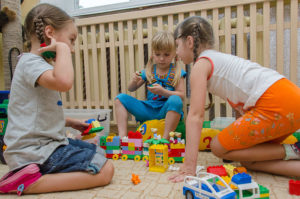What you’ll learn to do: Solve problems using the volume and surface area of solid figures
Josie is a kindergarten teacher and wants to make felt toys for her students. These felt toys will be cylinders, meant to replicate cans. She wants to put the felt toys in the new play kitchen in her classroom. To find the amount of felt she needs, Josie will need to calculate the surface area of the cans she plans to make. This chapter will explain how to find surface area of different objects, including cylinders.
Before you get started in this module, try a few practice problems and review prior concepts.
readiness quiz
1)
If you missed this problem, review these examples.
Evaluate [latex]{x}^{2}[/latex] when [latex]x=10[/latex].
[latex]\text{Evaluate }{2}^{x}\text{ when }x=5[/latex].
2)
If you missed this problem, review the videos below.
In this section, we will finish our study of geometry applications. We find the volume and surface area of some three-dimensional figures. Since we will be solving applications, we will once again show our Problem-Solving Strategy for Geometry Applications.
Problem Solving Strategy for Geometry Applications
- Read the problem and make sure you understand all the words and ideas. Draw the figure and label it with the given information.
- Identify what you are looking for.
- Name what you are looking for. Choose a variable to represent that quantity.
- Translate into an equation by writing the appropriate formula or model for the situation. Substitute in the given information.
- Solve the equation using good algebra techniques.
- Check the answer in the problem and make sure it makes sense.
- Answer the question with a complete sentence.
Candela Citations
- Kindergarteners Playing. Authored by: UNICEF Ukraine. Located at: https://commons.wikimedia.org/wiki/File:UNICEF_DSC_9422_(21243407812).jpg. License: CC BY: Attribution
- Examples: Determine the Circumference of a Circle. Authored by: James Sousa (Mathispower4u.com). Located at: https://youtu.be/sHtsnC2Mgnk. License: CC BY: Attribution
- Example: Determine the Area of a Circle. Authored by: James Sousa (Mathispower4u.com). Located at: https://youtu.be/SIKkWLqt2mQ. License: CC BY: Attribution
- Question ID: 144879, 146611. Authored by: Lumen Learning. License: CC BY: Attribution. License Terms: IMathAS Community License CC-BY + GPL
- Prealgebra. Provided by: OpenStax. License: CC BY: Attribution. License Terms: Download for free at http://cnx.org/contents/caa57dab-41c7-455e-bd6f-f443cda5519c@9.757

